Elona Dupont
CAD-Recode: Reverse Engineering CAD Code from Point Clouds
Dec 18, 2024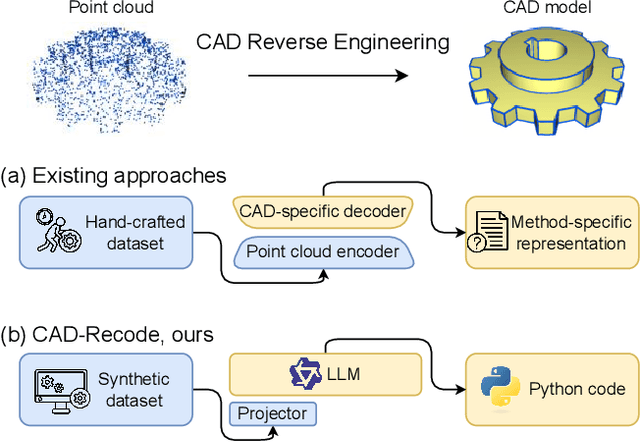
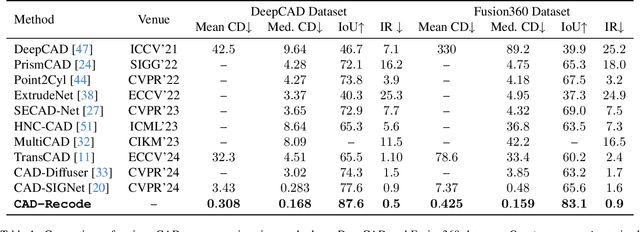
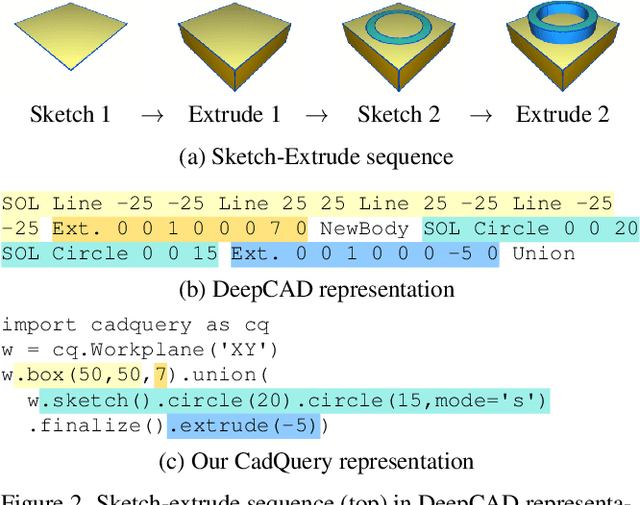

Abstract:Computer-Aided Design (CAD) models are typically constructed by sequentially drawing parametric sketches and applying CAD operations to obtain a 3D model. The problem of 3D CAD reverse engineering consists of reconstructing the sketch and CAD operation sequences from 3D representations such as point clouds. In this paper, we address this challenge through novel contributions across three levels: CAD sequence representation, network design, and dataset. In particular, we represent CAD sketch-extrude sequences as Python code. The proposed CAD-Recode translates a point cloud into Python code that, when executed, reconstructs the CAD model. Taking advantage of the exposure of pre-trained Large Language Models (LLMs) to Python code, we leverage a relatively small LLM as a decoder for CAD-Recode and combine it with a lightweight point cloud projector. CAD-Recode is trained solely on a proposed synthetic dataset of one million diverse CAD sequences. CAD-Recode significantly outperforms existing methods across three datasets while requiring fewer input points. Notably, it achieves 10 times lower mean Chamfer distance than state-of-the-art methods on DeepCAD and Fusion360 datasets. Furthermore, we show that our CAD Python code output is interpretable by off-the-shelf LLMs, enabling CAD editing and CAD-specific question answering from point clouds.
TransCAD: A Hierarchical Transformer for CAD Sequence Inference from Point Clouds
Jul 18, 2024Abstract:3D reverse engineering, in which a CAD model is inferred given a 3D scan of a physical object, is a research direction that offers many promising practical applications. This paper proposes TransCAD, an end-to-end transformer-based architecture that predicts the CAD sequence from a point cloud. TransCAD leverages the structure of CAD sequences by using a hierarchical learning strategy. A loop refiner is also introduced to regress sketch primitive parameters. Rigorous experimentation on the DeepCAD and Fusion360 datasets show that TransCAD achieves state-of-the-art results. The result analysis is supported with a proposed metric for CAD sequence, the mean Average Precision of CAD Sequence, that addresses the limitations of existing metrics.
CAD-SIGNet: CAD Language Inference from Point Clouds using Layer-wise Sketch Instance Guided Attention
Feb 27, 2024Abstract:Reverse engineering in the realm of Computer-Aided Design (CAD) has been a longstanding aspiration, though not yet entirely realized. Its primary aim is to uncover the CAD process behind a physical object given its 3D scan. We propose CAD-SIGNet, an end-to-end trainable and auto-regressive architecture to recover the design history of a CAD model represented as a sequence of sketch-and-extrusion from an input point cloud. Our model learns visual-language representations by layer-wise cross-attention between point cloud and CAD language embedding. In particular, a new Sketch instance Guided Attention (SGA) module is proposed in order to reconstruct the fine-grained details of the sketches. Thanks to its auto-regressive nature, CAD-SIGNet not only reconstructs a unique full design history of the corresponding CAD model given an input point cloud but also provides multiple plausible design choices. This allows for an interactive reverse engineering scenario by providing designers with multiple next-step choices along with the design process. Extensive experiments on publicly available CAD datasets showcase the effectiveness of our approach against existing baseline models in two settings, namely, full design history recovery and conditional auto-completion from point clouds.
SHARP Challenge 2023: Solving CAD History and pArameters Recovery from Point clouds and 3D scans. Overview, Datasets, Metrics, and Baselines
Aug 30, 2023



Abstract:Recent breakthroughs in geometric Deep Learning (DL) and the availability of large Computer-Aided Design (CAD) datasets have advanced the research on learning CAD modeling processes and relating them to real objects. In this context, 3D reverse engineering of CAD models from 3D scans is considered to be one of the most sought-after goals for the CAD industry. However, recent efforts assume multiple simplifications limiting the applications in real-world settings. The SHARP Challenge 2023 aims at pushing the research a step closer to the real-world scenario of CAD reverse engineering through dedicated datasets and tracks. In this paper, we define the proposed SHARP 2023 tracks, describe the provided datasets, and propose a set of baseline methods along with suitable evaluation metrics to assess the performance of the track solutions. All proposed datasets along with useful routines and the evaluation metrics are publicly available.
SepicNet: Sharp Edges Recovery by Parametric Inference of Curves in 3D Shapes
Apr 13, 2023Abstract:3D scanning as a technique to digitize objects in reality and create their 3D models, is used in many fields and areas. Though the quality of 3D scans depends on the technical characteristics of the 3D scanner, the common drawback is the smoothing of fine details, or the edges of an object. We introduce SepicNet, a novel deep network for the detection and parametrization of sharp edges in 3D shapes as primitive curves. To make the network end-to-end trainable, we formulate the curve fitting in a differentiable manner. We develop an adaptive point cloud sampling technique that captures the sharp features better than uniform sampling. The experiments were conducted on a newly introduced large-scale dataset of 50k 3D scans, where the sharp edge annotations were extracted from their parametric CAD models, and demonstrate significant improvement over state-of-the-art methods.
CADOps-Net: Jointly Learning CAD Operation Types and Steps from Boundary-Representations
Aug 22, 2022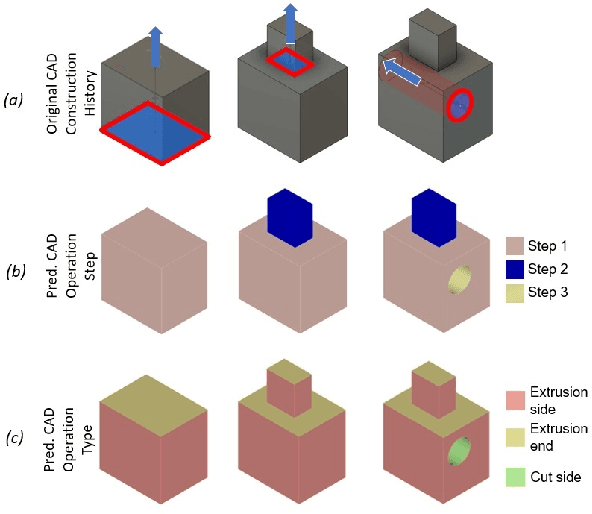

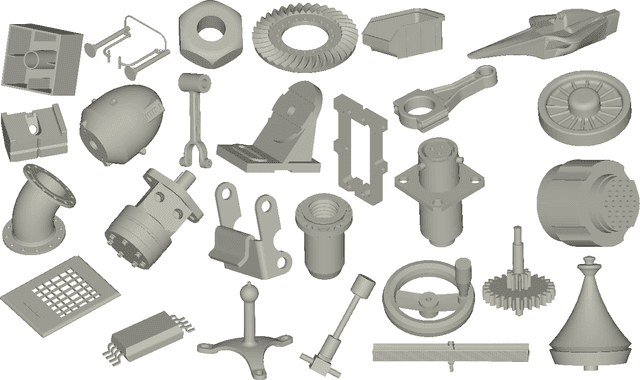

Abstract:3D reverse engineering is a long sought-after, yet not completely achieved goal in the Computer-Aided Design (CAD) industry. The objective is to recover the construction history of a CAD model. Starting from a Boundary Representation (B-Rep) of a CAD model, this paper proposes a new deep neural network, CADOps-Net, that jointly learns the CAD operation types and the decomposition into different CAD operation steps. This joint learning allows to divide a B-Rep into parts that were created by various types of CAD operations at the same construction step; therefore providing relevant information for further recovery of the design history. Furthermore, we propose the novel CC3D-Ops dataset that includes over $37k$ CAD models annotated with CAD operation type labels and step labels. Compared to existing datasets, the complexity and variety of CC3D-Ops models are closer to those used for industrial purposes. Our experiments, conducted on the proposed CC3D-Ops and the publicly available Fusion360 datasets, demonstrate the competitive performance of CADOps-Net with respect to state-of-the-art, and confirm the importance of the joint learning of CAD operation types and steps.
TSCom-Net: Coarse-to-Fine 3D Textured Shape Completion Network
Aug 22, 2022



Abstract:Reconstructing 3D human body shapes from 3D partial textured scans remains a fundamental task for many computer vision and graphics applications -- e.g., body animation, and virtual dressing. We propose a new neural network architecture for 3D body shape and high-resolution texture completion -- BCom-Net -- that can reconstruct the full geometry from mid-level to high-level partial input scans. We decompose the overall reconstruction task into two stages - first, a joint implicit learning network (SCom-Net and TCom-Net) that takes a voxelized scan and its occupancy grid as input to reconstruct the full body shape and predict vertex textures. Second, a high-resolution texture completion network, that utilizes the predicted coarse vertex textures to inpaint the missing parts of the partial 'texture atlas'. A thorough experimental evaluation on 3DBodyTex.V2 dataset shows that our method achieves competitive results with respect to the state-of-the-art while generalizing to different types and levels of partial shapes. The proposed method has also ranked second in the track1 of SHApe Recovery from Partial textured 3D scans (SHARP [38,1]) 2022 challenge1.
 Add to Chrome
Add to Chrome Add to Firefox
Add to Firefox Add to Edge
Add to Edge